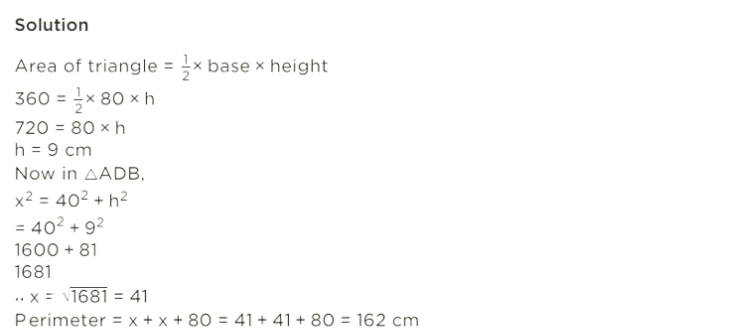

RS Aggarwal Solutions for Class 10 Maths Chapter 17 Exercise 17.1: RS Aggarwal Solutions for Class 10 Maths Chapter 17, Exercise 17.1 provide a detailed approach to solving problems related to the perimeter and area of plane figures. This exercise includes a range of problems designed to help students apply the formulas for various shapes such as rectangles, squares, and triangles.
Each solution is presented with clear, step-by-step explanations, making it easier for students to understand the methods and concepts involved. By working through these solutions, students can reinforce their understanding of how to calculate perimeters and areas, which is essential for mastering geometry and preparing for exams.RS Aggarwal Solutions for Class 10 Maths Chapter 17 Exercise 17.1 Overview
The solutions are explained clearly and step-by-step, helping students understand each method and apply it effectively. With these expert solutions students can build a strong grasp of the concepts, practice solving different types of problems and be well-prepared for their exams.RS Aggarwal Solutions for Class 10 Maths Chapter 17 Exercise 17.1 PDF
RS Aggarwal Solutions for Class 10 Maths Chapter 17, Exercise 17.1 PDF is a valuable resource for students looking to improve their skills in calculating perimeters and areas of plane figures. This PDF provides clear, step-by-step solutions to the problems in Exercise 17.1, making it easier for students to understand and practice the concepts.By using this PDF students can effectively work through the problems and strengthen their grasp of important geometry concepts. You can download the PDF using the link provided below to enhance your study and exam preparation.
RS Aggarwal Solutions for Class 10 Maths Chapter 17 Exercise 17.1 PDF
RS Aggarwal Solutions for Class 10 Maths Chapter 17 Exercise 17.1
Below we have provided RS Aggarwal Solutions for Class 10 Maths Chapter 17 Exercise 17.1 for the ease of the students –Q. Find the area of the triangle whose base measures 24 cm and the corresponding height measures 14.5 cm.
Q. Find the area of the triangle whose sides are 42 cm, 34 cm and 20 cm. Also, find the height corresponding to the longest side.
Q. Find the area for the triangle whose sides are 18 cm, 24 cm and 30 cm Also, find the height corresponding to the smallest side.
Q. The sides of a triangle are in the ratio 5 : 12 : 13 , and its perimeter is 150 m . Find the area of the triangle.
Q. The perimeter of a triangular field is 540 m, and its sides are in the ratio 25:17:12. Find the area of the field. Also, find the cost of ploughing the field at Rs. 40 per 100 m 2 .
Q. The perimeter of a right triangle is 40 cm and its hypotenuse measures 17 cm. Find the area of the triangle.
Q. The difference between the sides at right angles in a right-angled triangle is 7 cm, The area of the triangle is 60 c m 2 . Find its perimeter.
Q. The lengths of the two sides of a right triangle containing the right angle differ by 2 cm. If the area of the triangle is 24 c m 2 , find the perimeter of the triangle.
Q. Each side of an equilateral triangle is 10 cm. Find (i) the area of the triangle and (ii) the height of the triangle.
 In the above triangle, the measurement of the side DC is 5 cm. In the triangle ADC , the side AC is called hypotenuse side whose length is 10 cm. So we can say A C 2 = A D 2 + D C 2 10 2 = A D 2 + 5 2 100 = A D 2 + 25 100 − 25 = A D 2 A D 2 = 75 A D = √ 75 A D = 5 √ 3 Now we can apply the formula to find the area of triangle = 1 2 × b a s e × h e i g h t Here base is 10 cm and height is 5 √ 3 cm Area of the given triangle = 1 2 × 10 × 5 √ 3 = 5 × 5 √ 3 = 25 √ 3 c m 2
In the above triangle, the measurement of the side DC is 5 cm. In the triangle ADC , the side AC is called hypotenuse side whose length is 10 cm. So we can say A C 2 = A D 2 + D C 2 10 2 = A D 2 + 5 2 100 = A D 2 + 25 100 − 25 = A D 2 A D 2 = 75 A D = √ 75 A D = 5 √ 3 Now we can apply the formula to find the area of triangle = 1 2 × b a s e × h e i g h t Here base is 10 cm and height is 5 √ 3 cm Area of the given triangle = 1 2 × 10 × 5 √ 3 = 5 × 5 √ 3 = 25 √ 3 c m 2
Q. The height of an equilateral triangle is 6 cm. Find its area. [Take √ 3 = 1.73.]
Q. If the area of an equilateral triangle is 36 √ 3 c m 2 , find its perimeter.
Q. If the area of an equilateral triangle is 81 √ 3 c m 2 , find its height.
Q. The base of a right-angled triangle measures 48 cm and its hypotenuse measures 50 cm. Find the area of the triangle.
Q. The hypotenuse of a right-angled triangle is 65 cm and its base is 60 cm. Find the length of perpendicular and the area of the triangle.
Q. Find the area of a right-angled triangle, the radius of whose circumcircle measures 8 cm and the altitude drawn to the hypotenuse measures 6 cm.
Q. Find the lenght of the hypotenuse of an isosceles right-angled triangle whose area is 200 c m 2 . Also, find its perimeter. [Given, √ 2 = 1.41.]
Q. The base of an isosceles triangle measures 80 cm and its area is 360 c m 2 Find the perimeter of the triangle.

Benefits of RS Aggarwal Solutions for Class 10 Maths Chapter 17 Exercise 17.1
- Detailed Explanations: Each solution is broken down step-by-step, making it easy for students to follow and understand the process of calculating perimeters and areas.
- Expert Guidance: The solutions are prepared by subject experts ensuring that the methods and explanations are accurate and reliable.
- Improved Understanding: Working through these solutions helps students grasp important geometric concepts and apply the correct formulas to various problems.
- Confidence Building: By practicing with these solutions, students can build confidence in their ability to solve geometry problems, leading to better performance in their exams.
RS Aggarwal Solutions for Class 10 Maths Chapter 17 Exercise 17.1 FAQs
What is the perimeter of a plane figure?
What is a plane figure?
How do you calculate the area of a rectangle?
What are some common mistakes to avoid when calculating perimeter and area?












